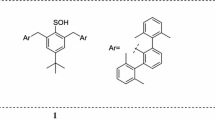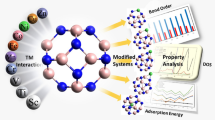Abstract
Magnesium dimers play important roles in inorganic and organometallic chemistry. This study evaluates the inherent bridging ability of a range of different ligands in magnesium dimers. In the first part, the Cambridge Structural Database is interrogated to establish the frequency of different types of ligands found in bridging versus terminal positions in two key structural motifs: one in which there are two bridging ligands (the D 2h “Mg2(μ-X2)” structure); the other in which there are three bridging ligands (the C 3v “Mg2(μ-X3)” structure). The most striking finding from the database search is the overwhelming preference for magnesium dimers possessing two bridging ligands. The most common bridging ligands are C-, N-, and O-based. In the second part, DFT calculations (at the B3LYP/6-311+G(d) level of theory) are carried out to examine a wider range of structural types for dimers consisting of the stoichiometries Mg2Cl3R and Mg2Cl2R2, where R = CH3, SiH3, NH2, PH2, OH, SH, CH2CH3, CH=CH2, C≡CH, Ph, OAc, F and Br. Consistent with the database search, the most stable magnesium dimers are those that contain two bridging ligands. Furthermore, it was demonstrated that the electronic effect of the bridging ligands is important in influencing the stability of the magnesium dimers. The preference for a bridging ligand, which reflects its ability to stabilize a magnesium dimer, follows the order: OH > NH2 > C≡CH > SH > Ph > Br > PH2 = CH=CH2 > CH2CH3 > CH3 > SiH3. Finally, the role that the ether solvent Me2O has on the stability of isomeric Mg2Cl2Me2 dimers was studied. It was found that the first solvent molecule stabilizes the dimers, while the second solvent molecule can either have a stabilizing or destabilizing effect, depending on the isomer structure.

A combination of database examination and DFT calculations reveals insights into the preferred number and type of bridging ligand in magnesium dimer






Similar content being viewed by others
References
Markies PR, Akkerman OS, Bickelhaupt F, Smeets WJJ, Spek AL (1991) X-ray structural-analyses of organomagnesium compounds. Adv Organomet Chem 32:147–226
Weiss E (1993) Structures of organo alkali-metal complexes and related-compounds. Angew Chem Int Ed 32(11):1501–1523
Holloway CE, Melnik M (1994) Structural aspects of grignard-reagents. Coord Chem Rev 135:287–301
Holloway CE, Melnik M (1994) Magnesium compounds - classification and analysis of crystallographic and structural data. J Organomet Chem 465(1–2):1–63
Uhm HL (1996) Crystal structures of grignard reagents. In: Silverman GS, Rakita PE (eds) Handbook of grignard reagents. Dekker, New York, p 117
Bickelhaupt F (2000) In: Richey HG (ed) Grignard reagents: New developments. Wiley, Chichester, p 299
Fromm KM, Gueneau ED (2004) Structures of alkali and alkaline earth metal clusters with oxygen donor ligands. Polyhedron 23(9):1479–1504
Jastrzebski JTBH, Boersma J, van Koten G (2008) In: Rappoport Z, Marek I (eds) The chemistry of organomagnesium compounds. Wiley, Chichester, UK, p 1
Hanusa TP (2007) In: Mingos DM, Crabtree RH (eds) Comprehensive organometallic chemistry iii, vol 2. Elsevier, Amsterdam, pp 78–114
Hill EA (1994) In: King RB (ed) Encyclopedia in inorganic chemistry, vol 1. Wiley, Chichester, pp 245–267
Molnar J, Marsden CJ, Hargittai M (1995) Molecular-structures and force-fields of monomeric and dimeric magnesium dichloride from electron-diffraction and quantum-chemical calculations. J Phys Chem 99(22):9062–9071
Reffy B, Kolonits M, Hargittai M (2005) Molecular structure of magnesium dibromide: An electron diffraction and quantum chemical study. J Phys Chem A 109(37):8379–8384
Luhtanen TNP, Linnolahti M, Laine A, Pakkanen TA (2004) Structural characteristics of small magnesium dichloride clusters: A systematic theoretical study. J Phys Chem B 108(13):3989–3995
Donald KJ, Hoffmann R (2006) Solid memory: Structural preferences in group 2 dihalide monomers, dimers, and solids. J Am Chem Soc 128(34):11236–11249
Aljuaid SS, Eaborn C, Hitchcock PB, Jaggar AJ, Smith JD (1994) The reaction of (Me3Si)3CBr with Mg in tetrahyrofuran (thf) or diethyl-ether - crystal-structure of (Me3Si)3CMg(mu-Br)3 Mg(thf)3. J Organomet Chem 469(2):129–133
Sakamoto S, Imamoto T, Yamaguchi K (2001) Constitution of grignard reagent rmgcl in tetrahydrofuran. Org Lett 3(12):1793–1795
Sobota P, Utko J, Lis T (1984) Preparation and crystal-structure of tri-mu-chloro-hexakis(tetrahydrofuran)dimagnesium(II) pentachloro(tetrahydrofuran)titanate(IV). J Chem Soc, Dalton Trans (9):2077–2079
Yamabe S, Yamazaki S (2008) In: Rappoport Z, Marek I (eds) The chemistry of organomagnesium compounds. Wiley, Chichester, UK, pp 369–402
Ertel TS, Bertagnolli H (2000) In: Richey HG (ed) Grignard reagents: New developments. Chichester, Wiley
Axten J, Troy J, Jiang P, Trachtman M, Bock CW (1994) An ab-initio molecular-orbital study of the grignard-reagents CH3MgCl and CH3MgCl2 - the schlenk equilibrium. Struct Chem 5(2):99–108
Yamazaki S, Yamabe S (2002) A computational study on addition of grignard reagents to carbonyl compounds. J Org Chem 67(26):9346–9353
Mori T, Kato S (2007) Analytical rism-MP2 free energy gradient method: Application to the schlenk equilibrium of grignard reagent. Chem Phys Lett 437(1–3):159–163
Mori T, Kato S (2009) Grignard reagents in solution: Theoretical study of the equilibria and the reaction with a carbonyl compound in diethyl ether solvent. J Phys Chem A 113(21):6158–6165
Yang KC, Chang CC, Huang JY, Lin CC, Lee GH, Wang Y, Chiang MY (2002) Synthesis, characterization and crystal structures of alkyl-, alkynyl-, alkoxo- and halo-magnesium amides. J Organomet Chem 648(1–2):176–187
Allan JF, Clegg W, Henderson KW, Horsburgh L, Kennedy AR (1998) Solvent effects and molecular rearrangements during the reaction of hauser bases with enolisable ketones: Structural characterization of {(BuC)-C-t(=CH(2))OMgBr.HMPA}(2) and MgBr2.(HMPA)(2). J Organomet Chem 559(1-2):173–179
Allen FH (2002) The cambridge structural database: A quarter of a million crystal structures and rising. Acta Crystallogr B B58(3):380–388
Bergerhoff G, Brown ID (1987) Crystallographic databases. International Union of Crystallography, Chester
Frisch MJ, Trucks GW, Schlegel HB, Scuseria GE, Robb MA, Cheeseman JR, Montgomery JA, Vreven T, Kudin KN, Burant JC, Millam JM, Iyengar SS, Tomasi J, Barone V, Mennucci B, Cossi M, Scalmani G, Rega N, Petersson GA, Nakatsuji H, Hada M, Ehara M, Toyota K, Fukuda R, Hasegawa J, Ishida M, Nakajima T, Honda Y, Kitao O, Nakai H, Klene M, Li X, Knox JE, Hratchian HP, Cross JB, Adamo C, Jaramillo J, Gomperts R, Stratmann RE, Yazyev O, Austin AJ, Cammi R, Pomelli C, Ochterski JW, Ayala PY, Morokuma K, Voth GA, Salvador P, Dannenberg JJ, Zakrzewski VG, Dapprich S, Daniels AD, Strain MC, Farkas O, Malick DK, Rabuck AD, Raghavachari K, Foresman JB, Ortiz JV, Cui Q, Baboul AG, Clifford S, Cioslowski J, Stefanov BB, Liu G, Liashenko A, Piskorz P, Komaromi I, Martin RL, Fox DJ, Keith T, Al-Laham MA, Peng CY, Nanayakkara A, Challacombe M, Gill PMW, Johnson B, Chen W, Wong MW, Gonzalez C, Pople JA (2003) Gaussian 03, revision b.04. Pittsburg, PA
Hinze J, Jaffe HH (1962) Electronegativity. 1. Orbital electronegativity of neutral atoms. J Am Chem Soc 84(4):540
Pritchard HO, Skinner HA (1955) The concept of electronegativity. Chem Rev 55(4):745–786
Bergmann D, Hinze J (1996) Electronegativity and molecular properties. Angew Chem Int Ed 35(2):150–163
Allen LC (1989) Electronegativity is the average one-electron elergy of the valence-shell electrons in ground-state free atoms. J Am Chem Soc 111:9003–9014
Anusiewicz I, Skurski P (2007) Unusual structures of Mg2F5- superhalogen anion. Chem Phys Lett 440(1–3):41–44
Anusiewicz I (2008) Mg2Cl5- and Mg3Cl7- superhalogen anions. Aust J Chem 61(9):712–717
Khairallah GN, Thum C, O'Hair RAJ (2009) A second metal center enhances the reactivity of an organomagnesate: Comparison of the gas-phase reactions of water with RCCMgCl2(-) and RCCMg2Cl4(-) (R = H, PH). Organomet 28(17):5002–5011
Acknowledgments
We thank the Australian Research Council for financial support via Grant# DP0558430 and Victorian Institute for Chemical Sciences for the Chemical Sciences High Performance Computing Facility. We thank Associate Professor Brendan Abrahams for helping to search the Inorganic Crystal Structure Database.
Author information
Authors and Affiliations
Corresponding author
Electronic supplementary material
Below is the link to the electronic supplementary material.
ESM 1
(DOC 4546 kb)
Rights and permissions
About this article
Cite this article
Lioe, H., White, J.M. & O’Hair, R.A.J. Preference for bridging versus terminal ligands in magnesium dimers. J Mol Model 17, 1325–1334 (2011). https://doi.org/10.1007/s00894-010-0834-1
Received:
Accepted:
Published:
Issue Date:
DOI: https://doi.org/10.1007/s00894-010-0834-1




